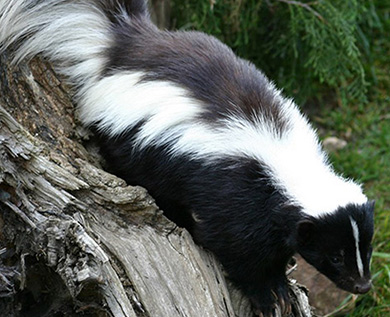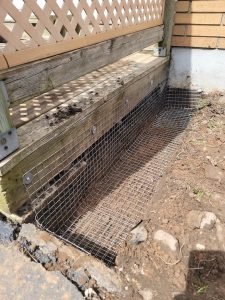What’s That Smell!? Dealing with Skunks: Removal and Prevention

Skunks are small mammals known for their distinctive black and white stripes and notorious defensive spray. While they are generally shy and non-aggressive creatures, skunks can become a nuisance when they decide to take up residence on your property. Skunks can dig burrows, damage lawns, and cause unpleasant odors that can linger for weeks. Dealing with skunks requires careful identification, safe removal, and effective preventative measures to keep them from returning.
In this article, we will provide you with a comprehensive guide on how to identify if skunks are living on your property, how to remove them safely and humanely, and how to prevent future infestations. By following these methods, you can effectively deal with skunks and protect your home from their unwanted presence.
Identifying Skunks on Your Property
The first step in dealing with skunks is by identifying their presence. Skunks are nocturnal creatures, which means they are most active during the night and rest during the day. Here are some signs that may indicate skunks have taken up residence:
Digging and Burrows
Skunks are excellent diggers, and may create burrows while looking for food or when creating a den. Be on the lookout for holes in the ground, paying close attention to areas such as sheds, decks, or near the edges of your yard. Skunks typically dig small, cone-shaped holes with loose soil.
Strong Odor
Skunks are well-known for their defensive spray, which has a very strong, pungent odor. If you notice a persistent, foul smell around your property, especially at night, it could be one of the first signs of skunk activity.
Tracks and Droppings
Skunks have distinct tracks and droppings that can help identify their presence. Skunk tracks resemble those of a small dog, with five toes on the front and back feet, and often show claw marks. Skunk droppings have a tubular shape, measuring about 1/4 to 1/2 inch in diameter, and may contain undigested insect parts or seeds.
Damage to Lawns and Gardens
Skunks are known to be opportunistic feeders, and may dig up lawns or gardens in search of grubs, insects, or other small animals to eat. If you notice irregular patches of upturned soil in your lawn or garden, it could be an indication of a foraging skunk.
Sightings
If you spot a skunk around your home, it may simply be passing through or it could mean that they have an active den nearby. Skunks are usually active during the night and may be seen searching for food, traveling about, or (unfortunately) spraying if they feel threatened.
It is important to note that skunks are wild animals who may look cute, but can carry serious diseases such as rabies. Therefore, it is crucial to exercise caution and avoid direct contact with skunks or their dens. If you suspect skunk activity on your property, it is best to contact your local wildlife removal experts who can take the appropriate measures to safely and humanely eradicate them from your property.
Safely Removing Skunks
Skunks are generally shy and prefer to avoid confrontation, but they can certainly choose to spray if they at all feel threatened. Therefore, it is essential to take proper precautions when removing skunks to avoid that risk. Wildlife removal professionals are trained and experienced to handle skunks in various situations, while having specialized knowledge and equipment at their disposal. They will conduct a thorough assessment of the skunk activity on your property to determine the extent of the infestation and the best approach for removal. They will consider factors such as the location of the den, the number of skunks, as well as the time of year – skunks may have babies (kits) during specific seasons. This assessment will help them develop a customized removal/exclusion plan.
Live Traps
The most well-known method for skunk removal is live trapping, however it is not something that is generally recommended. A humane trap is set near the skunk den or area where the skunk is known to frequent, baited with appropriate food sources. If the skunk is successfully trapped, the wildlife expert will carefully and safely transport the animal somewhere as far away as possible to release it back into the wild unharmed. In Ontario, there are laws in place that inhibit how far wildlife can be relocated from where they are found (approximately 1KM), so there is a chance the skunk could return. By taking the skunk elsewhere, it decreases its chances of survival since it ends up in an unfamiliar area. Also, there is no guarantee if a skunk will go into the trap or not, so it’s a method that may not produce any positive result. For these reasons, trapping is typically used only as a last resort option in very specific circumstances.
Exclusion Techniques
To prevent skunks from returning to your property, wildlife removal professionals often implement the use of exclusion techniques. This involves sealing off access points to the skunk den or other areas where skunks may enter, such as around decks, sheds, or foundations, with heavy-duty materials such as steel mesh. This prevents skunks from re-entering these spaces and establishes a barrier to keep them out in the future.

Once skunks are no longer an issue on your property, affected areas should be assessed for any possible health risks. Skunks can leave behind droppings, urine, or other debris. Factors such as where the skunk was living, how long it was there, and reasonable access to the area often determines what necessary measures to take. If required, a wildlife technician may recommend to clean and sanitize the area by removing feces and soiled debris, or using a disinfectant to ensure everything is safe and sanitary.
It is important to continue to monitor the area after removal to ensure that they do not return. If a one-way door had been installed to allow skunks to exit from their den, a follow-up visit is conducted to check for any signs of activity and to make sure that all exclusion techniques have been effective in keeping the skunks out permanently.
Preventing Future Skunk Infestations
It is important to take as many preventive measures as possible to reduce the risks of skunks returning to your property and attempting to live there in future seasons.
Here are some steps you can take to prevent further skunk occurrences:
- Remove Attractants: Skunks are attracted to food sources such as garbage, pet food, and bird seed. Make sure to secure any trash cans with tight-fitting lids, always store pet food indoors, and clean up any fallen bird seed or other easy food sources in your yard.
- Keep Your Yard Clean and Tidy: Skunks may take shelter in overgrown vegetation, woodpiles, or other debris present in your yard. Keep things clean and tidy by trimming overgrown vegetation, removing woodpiles, and clearing away debris that may provide much-needed shelter for skunks and their babies.
- Install Motion-Activated Lights or Sprinklers: Skunks are nocturnal creatures and are sensitive to bright lights or sudden noises. Install motion-activated lights or sprinklers in areas where skunks may be active to deter them from entering your property. Install Protective Fencing
- Install Protective Fencing: Much like the exclusion work performed by wildlife removal technicians, installing a sturdy fence around your property can be an effective way to prevent skunks from being able to enter. Make sure the fence is buried at least a foot underground to prevent skunks from digging underneath, and the height of the fence should be tall enough to deter skunks from climbing over (luckily they are poor climbers!). Consider using materials such as heavy-duty hardware cloth or mesh fencing that are difficult for skunks to chew through or get under.
- Remove Water Sources: Skunks are attracted to various water sources such as ponds, birdbaths, or exterior leaks. Eliminate standing water in your yard, and be sure to fix any leaks or drips to reduce the attractiveness of your property to skunks and other animals.
- Keep Pet Doors Secure: If you have a pet door in your home, make sure it is secure and only accessible to your pets. It doesn’t happen often, but skunks can accidentally enter through pet doors and gain access inside your home, so ensure that the pet door is locked or closed at night or when you are not around. Use Repellents
- Use Repellents: There are many different natural and commercial repellents available to purchase that can deter skunks from entering your property. Some common natural repellents include ammonia-soaked rags, pepper spray, or citrus peels. Commercial repellents may contain ingredients like predator urine or other chemicals that can help to repel skunks. Always follow the instructions and safety guidelines when using repellents and consider reapplying them after rain or as often as needed.
- Educate Yourself and Others: Understanding skunk behavior and habits can help you identify signs of skunk activity on your property and take appropriate measures to prevent further issues. Educate yourself and others in your household about skunks, their habits, and what to do if one is seen closeby. Skunks, like all animals, are important to our ecosystem and we need to learn how to live among them in peace.
Dealing with skunks on your property can be a challenging and unpleasant situation. However, by taking proactive measures to identify, remove, and prevent future infestations, it is an issue that can be effectively managed. It is essential to work with wildlife removal professionals who have the knowledge, expertise, and equipment to safely and humanely remove skunks. Following proper exclusion techniques and implementing preventive measures can help you maintain a skunk-free environment, and protect your property from the damage and potential health risks associated with skunk infestations.
If you are unsure or have questions about a skunk sighting, or to know if they have decided to live in your yard somewhere, it is always best to seek professional assistance to ensure the safety of both you and the skunks. Call us or email us for a free estimate

